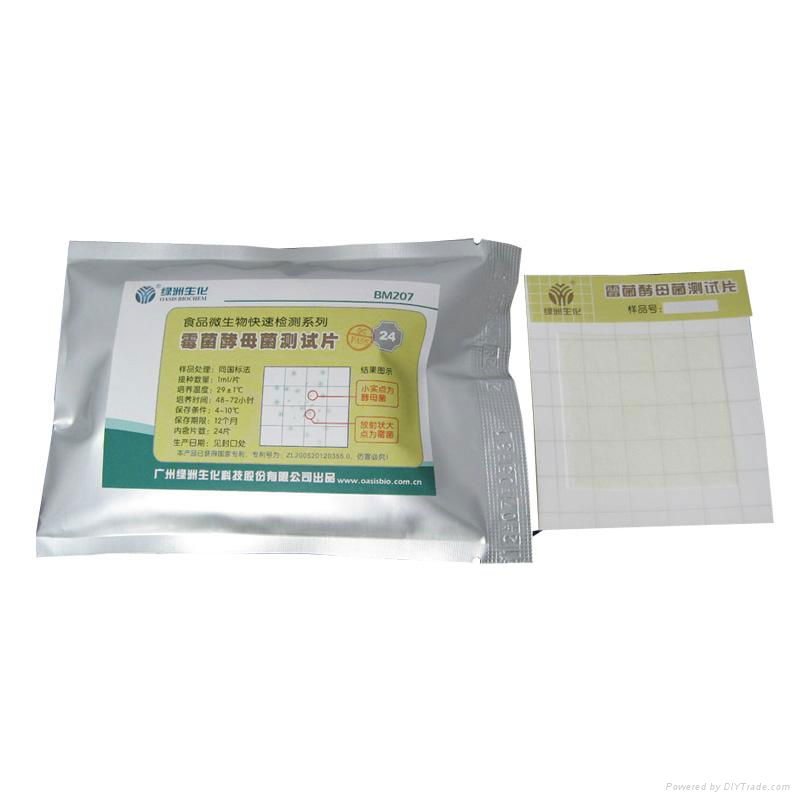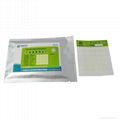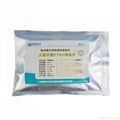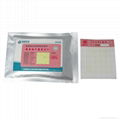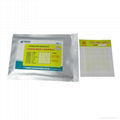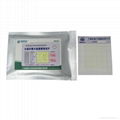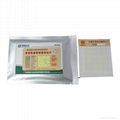| Model: | BM207 |
|---|---|
| Brand: | Oasis |
| Origin: | Made In China |
| Category: | Industrial Supplies / Other Industrial Supplies |
| Label: | count plate , mold & yeast , food safety |
| Price: |
US $24
/ pc
|
| Min. Order: | 1 pc |
Product Description
1.Principle & application scope
Mold such as aspergillus and yeast exists widely in the air ,water and earth. Most of them are harmless ,however some mold are harmful for human health,such as aspergillus which could secrete aflatoxin which is a strong carcinogen. Mold can also stimulate human stomach and intestine, even cause food poisoning and injure liver. Mould & yeast count plate which consist of nutrient medium, bibulous gel, and chromogenic reagent could greatly save the time of medium preparation, disinfection, and dish cleaning. This kind of plates which is easy to use and very convenient could be widely used in institutes of Food hygiene inspection and food factories.
Executive standard : Food safety national standard , food microbiology testing mould (GB 4789.15)
2. Using method
2.1 Sample preparation: Prepare the 1:10 solution by placing 25g or 25mL sample into 225mL sterile distilled water, then prepare 1:100 solution by suck 1mL solution(1:10) into 9mL sterile distilled water. By analogy, prepare tenfold increasing serial dilution.
2.2 Inoculation: Select 2-3 appropriate dilution ratio to do the test for ordinary food, while for some liquid sample which has little coliform directly suck raw liquid to do the test . Place the count plate onto sterile experiment table, uncover the film on the surface. Suck 1mL solution with sterile pipette, and then drop it slowly and evenly onto the count plate, cover the film gently and stand it for 10s to let the medium solidify. Inoculate two count plate for each dilution ratio, and at the meantime do a blank control.
2.3 Culture: Superimpose these count plates and place them back into ziplock bags and seal them well. Then place the count plates in the incubator at 28℃±1℃ for 48-72h with the transparent side up. The quantity of superimposed plates should not be more than 12.
3.Results:
Mold and yeast would show blue spots after cultivation. Colony of Mold is radial and relatively large compared with yeast, while colony of yeast is round and relatively small. Count the colony number by choosing the plate which contain the 10~100 colonies ,and then multiply it by corresponding dilute multiple.
4.Counting method and report
4.1 Counting
4.1.1 Select the count plates of which the colony quantity is between 10CFU and 150CFU to do the counting. Multiply the average number of colonies by the corresponding dilution multiple.
4.1.2 If the quantity on all the dilute ratio count plates is more than 150CFU, count the quantity of colonies on maximum dilution multiple count plates, and multiply it by maximum dilution multiple.(see Example 1 in the following table)
4.1.3 If the quantity of colonies on all the dilution ratio count plates is less than 10CFU, count the quantity of colonies on the minimum dilution multiple count plates, and multiply it by the minimum dilution multiple as report data. (see Example 2 in the following table)
4.1.4 If there is not any mould and yeast growing on all dilution ratio count plates (incl. original liquid sample), report the result in terms of less than one multiplied by minimum dilution multiple. (see Example 3 in the following table)
4.2 Report
4.2.1If the quantity of colonies is less than 100, round it as per rounding-off rule and use the first two digits to report it in terms of scientific notation.
4.2.2 If the quantity of colonies is not less than 100, round the third digit as per rounding-off rule, and use the first two digits to report it in terms of scientific notation.
4.2.3 Use CFU/g as report unit for solid sample, and use CFU/mL as report unit for liquid sample.
|
example |
Dilute ratio & quantity of mould |
Select dilute ratio as counting |
Report data (CFU/g or CFU/mL) |
||
|
10-1 |
10-2 |
10-3 |
|||
|
1 |
So many |
352 |
169 |
10-3 |
1.7*105 |
|
2 |
8 |
5 |
1 |
10-1 |
8.0*10 |
|
3 |
0 |
0 |
0 |
<1 *10 |
<1*10 |
5. Additional explanatory note
It is demanded that mould and yeast can’t be detected for most sample, while mould and yeast widely spread in the air in the form of spore.Therefore, It is essential to operate carefully when using mold & yeast count plate All the utensils and articles including sampling tools ,dilute water and sucker and so on should be thoroughly disinfected .And avoid air flow and do a quick action during inoculation. It’s better to make two contrast with sterilized saline to avoid the false positive results.
6. Preservation condition
This kind of count plate should be placed in the fridge of 4℃-10℃,and the expiration time is one year. Once the package is opened, those unused count plates should be placed back to the package and seal well. And placed them in the fridge, and exhaust them within one month. Condense water may occur in high humid environment , and it is better to warm it to room temperature before unfolding the package.
Member Information
| Guangdong Dayuan Oasis Food Safety Technology Co.,Ltd | |
|---|---|
| Country/Region: | Guang Dong - China |
| Business Nature: | Manufacturer |
| Phone: | 13745444520 |
| Contact: | Phoebe Zhang (Executive of Foreign) |
| Last Online: | 17 Mar, 2017 |
Related Products of this Company
-
Coliform count plate
US $25
-
Pesticide residue rapid detecting card
US $7.5
-
E.coli STEC count plate
US $37
-
E.coli O157 count plate
US $37
-
Enterobacter sakazaii count plate
US $32
-
Bacteria colony count plate
US $17.5
-
E.coli & thermotolerant coliform
US $29
-
E.coli & coliform count plate
US $29
-
Salmonella count plate
US $35
-
Staphylococcus aureus count plate
US $37
